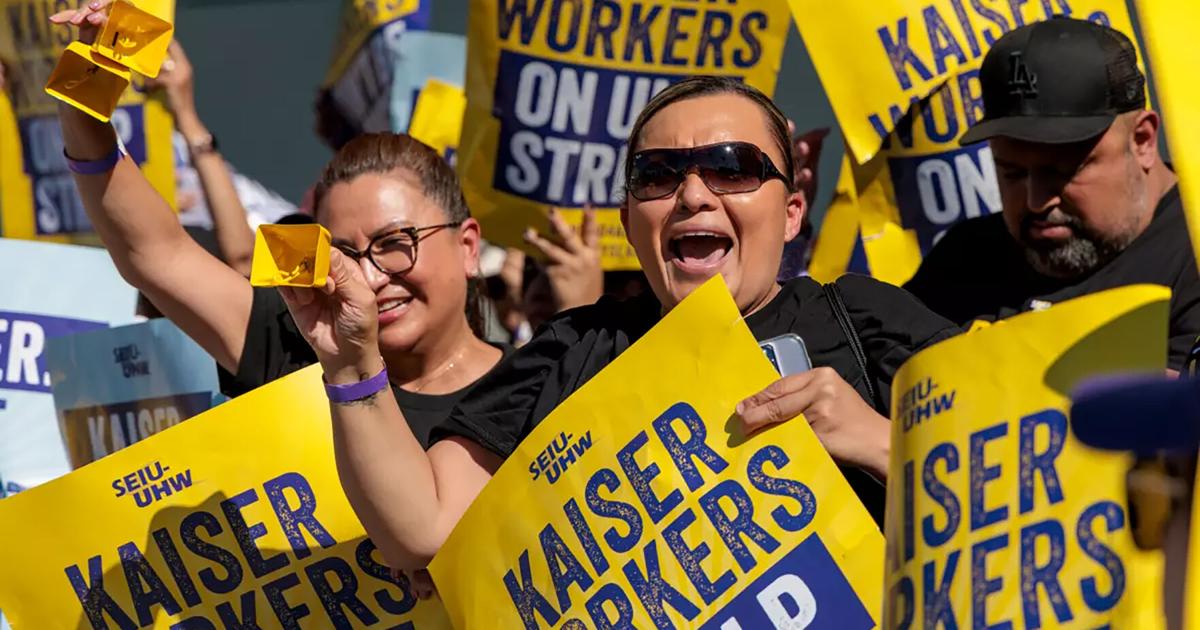The largest health care strike in U.S. history was called off last week when Kaiser Permanente and unions representing 75,000 workers finally reached a temporary agreement. This follows a planned three-day work stoppage by unions that has given their employers a preview of what will happen if the standoff continues. Kaiser clearly didn’t want to see more.
This is good news for American workers, who have been quick to feel the pinch from record high inflation but have been slow to reap the benefits of the record profits that come with it. According to the Bureau of Labor Statistics, since last August, we have seen 42 work stoppages of at least 1,000 employees nationwide. There’s a theme here, as the workers have been squeezed for so long as if the corporate brain believes The Hunger Games is an instruction book.
Everyone is also reading…
It’s not just that wages are rising slowly, and it’s not just that increases in housing and food prices have outstripped inflation. Look at the barriers we have created to ensure adequate child care.
As of late last month, states were facing the loss of $39 billion in federal funding for child care, a financial disaster that threatens the solvency of 70,000 programs, jobs for more than 200,000 workers and the care of more than 3 million children. .
Sen. Patty Murray (D-Washington) said there was a crisis in child care even before the pandemic. Last month, she and other Senate Democrats introduced a bill to try to soften the blow of losing this aid. This is an urgent economic priority at every level: Child care is what allows parents to work, businesses to hire workers, and it’s an investment in our children’s futures. The child care industry holds every sector of our economy.
Kaiser Permanente workers protest during a three-day health care strike on October 4 in Irvine, California.
Ryan Sun, Associated Press
Before the pandemic, the Department of Health and Human Services reported that the amount of money families spent on child care was about 40% more than what was considered affordable. Combine that with the fact that this year’s average salary increased at the same pace as last year’s. And the reality is that the purchasing power gap caused by record inflation is forecast to last until the end of 2024.
What exactly are working parents supposed to do?
While many white-collar industries offer child care options, the fastest-growing job sector is leisure and hospitality, which is not exactly a leader in the field. In Germany, municipalities are required by law to provide childcare. In America, they are less accommodating. Kind of like don’t have kids unless you can afford that attitude.
The problem is that we no longer have enough people who can raise children without help.
September marked the 33rd consecutive month that the US economy added jobs. Labor market participation rates have increased and there are more than 9 million job opportunities across the country. This is all great news unless you need childcare. Then you have to find out whether any jobs available to you pay more than you spend on child care, assuming you’re not among the 50% of Americans who live in areas called child care, areas in America before. -K more bodies than available quantity.
Murray said it’s a never-ending financial and logistical burden for the entire family.
Choose Medicaid, welfare, Social Security conservatives have historically talked about entitlements and the safety net as if those on benefits are lazy and not part of the workforce. The reality of how inaccurate that assessment is will soon confront them because of the link between labor and child care.
These people would rather cut government programs than fund social services, but there’s a worrying problem: If future workers can’t afford to work, then exactly How will austerity policy solve the problem?
When we talk about the work ethic of the greatest generation, we often leave out the part about the federal government stepping in and subsidizing child care. Without that assistance, most of the 6 million women who kept this country afloat during World War II would not have been able to enter the workforce.
By contrast, today, 68% of Oklahomans live in child care deserts. The state also estimates a shortage of 40,000 workers. Do you think it’s a coincidence?
The growth of the gig economy, combined with the passage of the Affordable Care Act, has created a path for more Americans to escape toxic work environments and become their own boss. theirs. The Great Resignation and a wave of labor strikes further highlighted the change in the relationship between labor and capital. However seismic those changes are, the biggest earthquake is yet to come. Paid family leave and affordable child care are no longer just items on liberals’ wish lists.
Like the rest of the industrialized world, the United States is slowly coming to grips with the reality that if you want people to work, the idea has to work for their children, too.
From the archives: ABA Virginia Planters
guard

This September 1970 image shows players vying for roster spots with the Virginia Squires, a franchise in the American Basketball Association – from left are Larry Brown, Charlie Scott, Henry Logan, Roland “Fatty ” Taylor and Mike Barrett. The team moved from Oakland to Washington to Richmond over a two-year period, having played in arenas from Roanoke to Norfolk during its time in Virginia starting in 1970. After achieving initial success, which included Drafting Julius Erving in 1971, the team faltered financially and lost fans when it sold Erving and its other star player, George Gervin. The team dissolved shortly before the ABA merged with the National Basketball Association in 1976.
Don Pennell
guard

January 1976: Rookie vs. Rookie at the Coliseum. San Antonios Mark Oberding (left) defends Squire Mel Bennett.
Times-Dispatch
guard

February 13, 1976.
Times-Dispatch
guard

September 1971: Practice The American Basketball Association Virginia Squires opened the first of two days of practice yesterday at Ft. Fieldworker Eustis Anderson. George Irvine (30) dribbles the ball during the warm-up while teammates Bill Bunting (16), Jim Eakins (42) and Mike Barrett (20) watch.
PA Gormus, Jr.
guard

April 13, 1973.
Times-Dispatch
guard

September 1975: Willie Wise hears from his boss. Squires coach Al Bianchi chats with the veteran striker during practice.
Carl Lynn
guard

September 1972: Fatty Taylor (right) explains the intricacies of defense. Rookie Dave Twardzik (13), Billy Shepherd takes lessons in pre-season camp.
Times-Dispatch
guard

TWO ROOKIES SQUIRES DISCUSSION TRAINING CAMP / Julius Erving (left), Willie Sojourner wait for today’s opening day. September 12, 1971.
guard

JULIUS ERVING THE SKY OVER THE BASKET / Jim Eakins, Davie Robinsch Watch Squire Operating. October 26, 1972.
guard

Julius Erving, Virginia Squires, photographed April 12, 1972.
guard

November 26, 1972: Julius Erving ‘Stuffs’ Two of 46 for the Squires
Gary Burns
guard

Julius Erving of the Virginia Squires on April 12, 1972.
Amir M. Pishdad
guard

In March 1972, the American Basketball Association’s Virginia Squires lost to the Indiana Pacers 117-112 at Richmond Coliseum. From left are Bernie Williams, who scored 19 points for the Squires; Jim Eakins, who added 15; and Freddie Lewis, who led the Pacers with 25 points on the night.
Bob Brown
guard

In February 1976, Dave Twardzik of the Virginia Squires faced off against Artis Gilmore of the Kentucky Colons en route to a 123-107 Squires victory before a crowd of just 1,017 at Richmond Coliseum. This was the final season for the American Basketball Association and the Squires, and their 15 wins matched their mark from the previous year as the worst in league history.
Wallace Clark
guard

In December 1975, Mike Jackson of the Virginia Squires challenged Denver’s Ralph Simpson to an American Basketball Association game at Richmond Coliseum. The Squires moved to Richmond in 1970 after a year in Washington as the Washington Caps.
Bill Lane
guard

In September 1972, Rudy Peele (left) and Al Sanders laugh during a break at the Virginia Squires rookie tryout camp in Richmond. Around 16 players are expected to be at the camp, including four who were invited after impressing at an open three-day tryout in Norfolk last week. That tryout drew 81 players hoping to catch the American Basketball Association team.
Don Pennell
LZ Granderson is a columnist for the Los Angeles Times.
#Granderson #U.S #policy #essentially #discourages #children #economy #paying #price
Image Source : richmond.com

